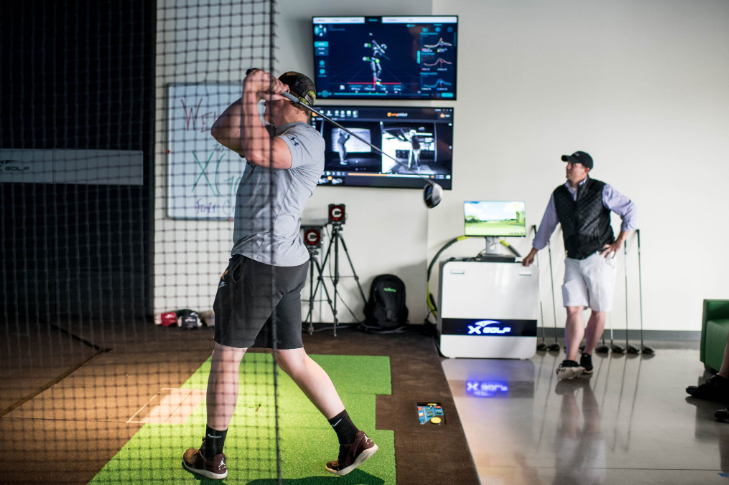At X-Golf, data of every shot you take is recorded and displayed right away on the screen for you. That includes a reading of your club path, clubhead speed, club impact location, ball direction, launch angle, ball speed, smash factor, backspin rate, sidespin rate, total shot distance, carry distance, shot peak height, and trajectory apex location. And it can be really confusing at first. As the resident teaching pro at X-Golf in Fort Collins, Colo., I see this everyday.
So what do all these numbers mean, and how can you use that data to improve your game? First of all, don’t feel bad if the numbers are baffling at first – that’s common. Some numbers make more sense than others. Like people generally know what clubhead speed is, and can figure out what ball speed is. But when you start getting into launch angle, ball spin rates and peak horizon, it can be daunting. If that’s you, just ask a staffer to explain.
As an instructor, my job isn’t to teach you how to play golf. It’s to teach you how to create a repetitive swing that creates predictability. So when you’re trying to create repeatable swings, you’re looking for swing data to validate what you’re trying to do. Ideally, you’d like to get your various numbers into a consistent range, and create less chaotic numbers that are all over the place. When you’re able to start creating number patterns based on what you’re trying to do, those numbers can really help to validate your swing or shot type, and how you’re putting it all together.
Some of those numbers may seem foreign, but they all play key roles in your swing. Let’s say the data show that your club path is either outside in or inside out. Then just try to keep things basic. Decide what you’re trying to do first. Are you trying to swing inside out? Or play a left-to-right shot? This number will tell you if you’re taking the proper swing path to accomplish that goal. So understanding what you’re trying to do and then letting the number validate that leads you in the direction of where you need to go. Remember that numbers are based on facts versus the feel of what you’re trying to do.
Many golfers see that the impact location – where the ball meets their clubface – is off-center. That could be caused by various factors. So you really want the X Golf pro to see your specific swing to help out. Your ability to create ball flight is going to be dictated by whether you hit the center of the face. The more off-center it is, the more chaos you’re bringing in and the less good data the launch monitor will provide. So a pro will help you understand how to find the center of the face. Then you can have a place to go from in trying to create less chaos by just getting the ball on center.
And then there’s the Holy Grail of swing data – your clubhead speed. The higher it is, the longer you hit the ball. How do you increase it? Learn to swing faster, but also learn to hit the center of the clubface more. Ball speed is a replication of hitting the center of the face – the more you can hit the ball on the center of the face, the faster it will go because more energy transfer will come from the clubhead to the ball itself. Smash factor is a great launch dynamic that helps you understand the efficiency of your ball contact. But clubhead speed alone isn’t relevant if you don’t hit the center of the face. So the clubhead speed without the smash factor, or without the ball speed, isn’t relevant.
All of these numbers are important to help you improve your game, and essentially work in concert with each other to help you get to that point. When you get a repetitive set of numbers and you’re hitting it how you want to is where the launch monitor and the ball speed launch dynamics really play a huge understanding about how you’re creating shots. So if you feel like you need to cover a certain number out in the fairway to clear a lake, and you hit the center of the face and carry it 10 yards farther, you need to know that you made impact on the center of the face, so you should be able to clear that hazard.
Having a coach gets you to understand the feel of what you’re trying to do versus the reality of what’s happening. That’s where video lessons and launch monitor data or launch dynamics can really help you validate what it is you’re feeling. The more you get, the more you can match the feel versus the reality of what’s happening – and generally, the better the results end up being.
Having an understanding of how your golf swing works and what it does or what it replicates is huge when you learn how to take it from an indoor environment at X-Golf to outside where you can actually take that data and see the picture versus what the numbers may tell you what’s going to happen. Being able to put those two things together – the feel of what you see outside versus the reality of numbers that you get inside – are actually a really magical thing when you put them together.
Next time you’re at X-Golf, keep it simple with data. Maybe focus on ball speed, smash factor, and carry distance. Try to create repetitive patterns based on those, making sure you get your ball speed to be the same with good center face contact – that’s really the key to creating a repetitive golf swing with predictable ball flight. And enlist one of our pros to help make sense of all the numbers and get you on the right path.

